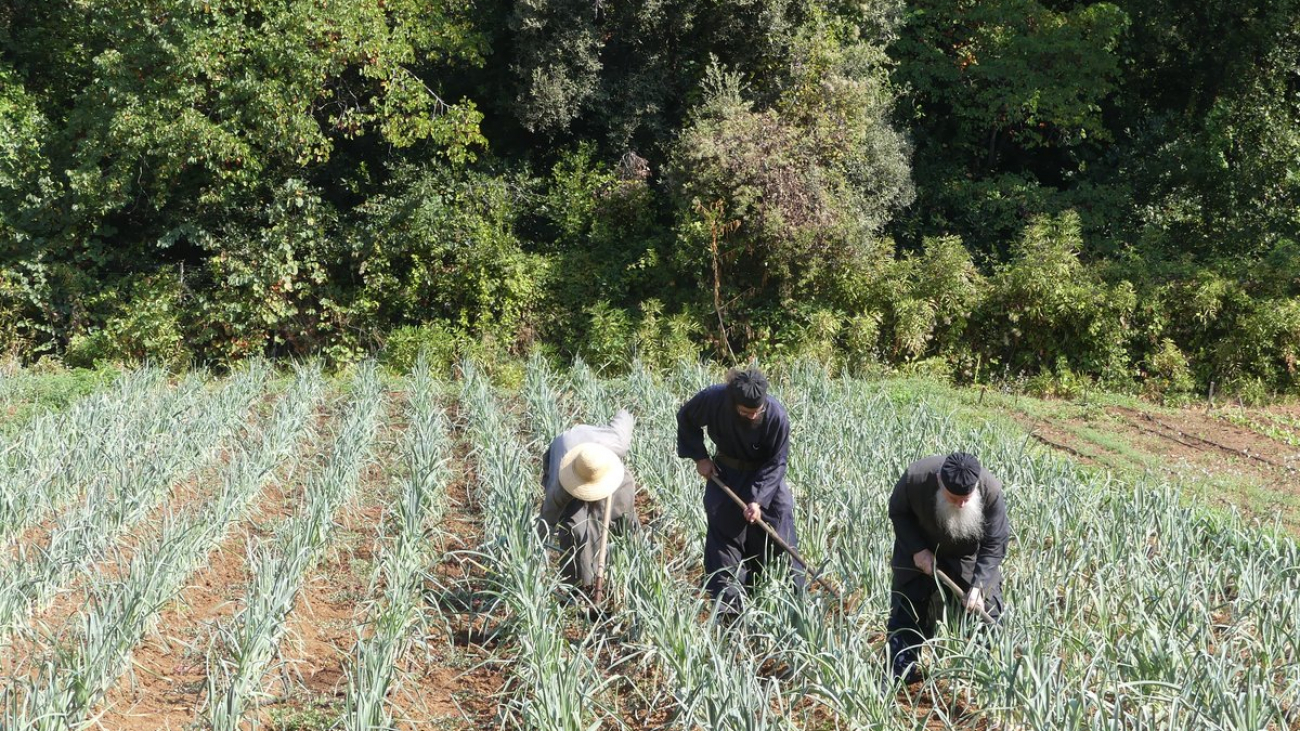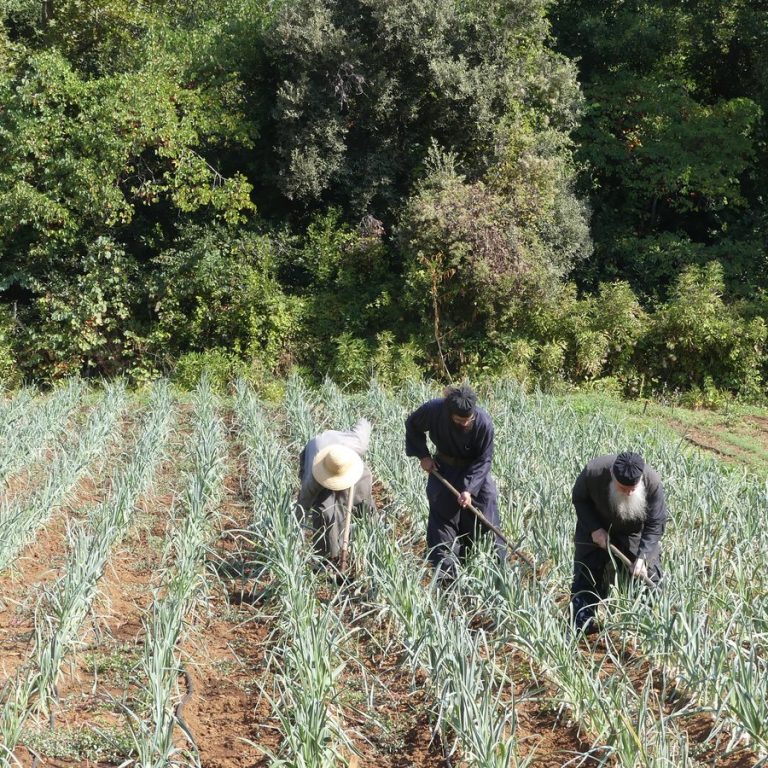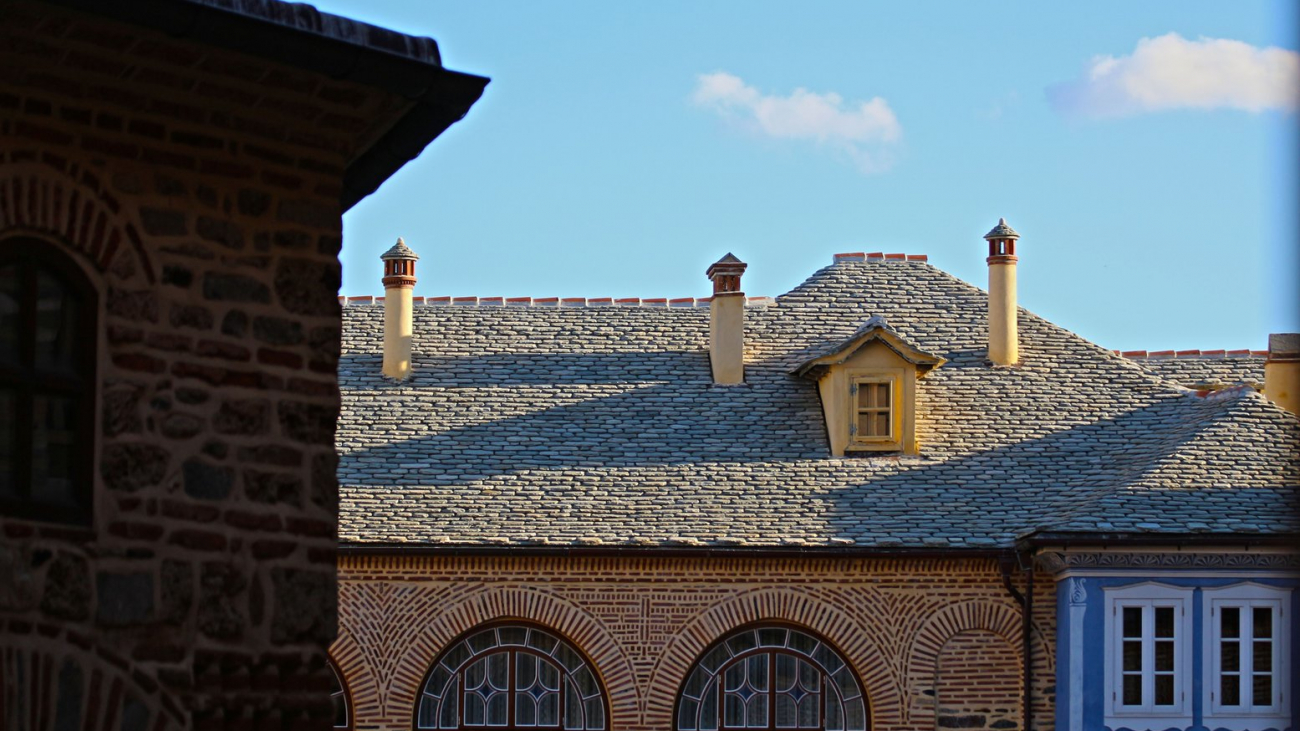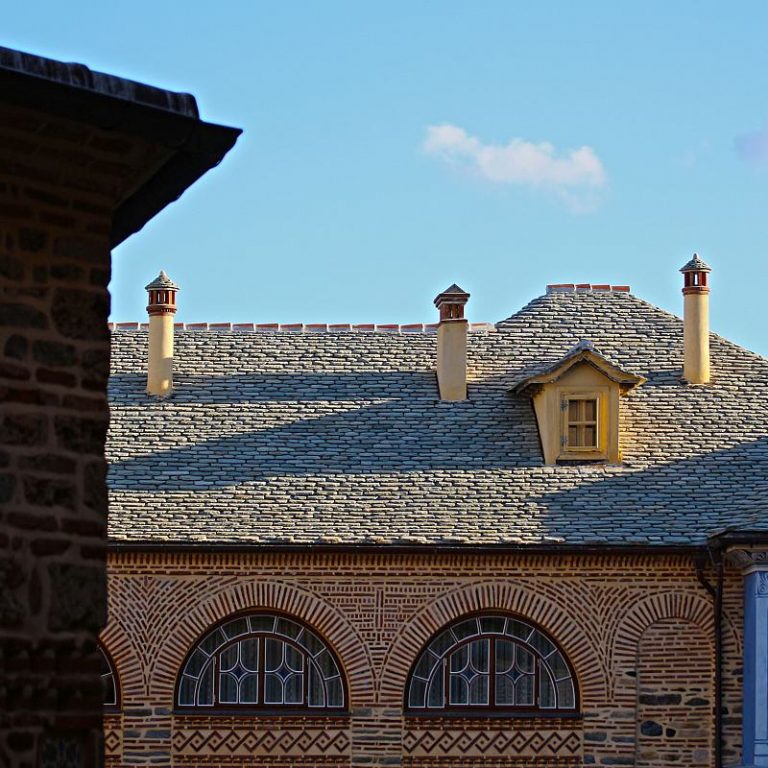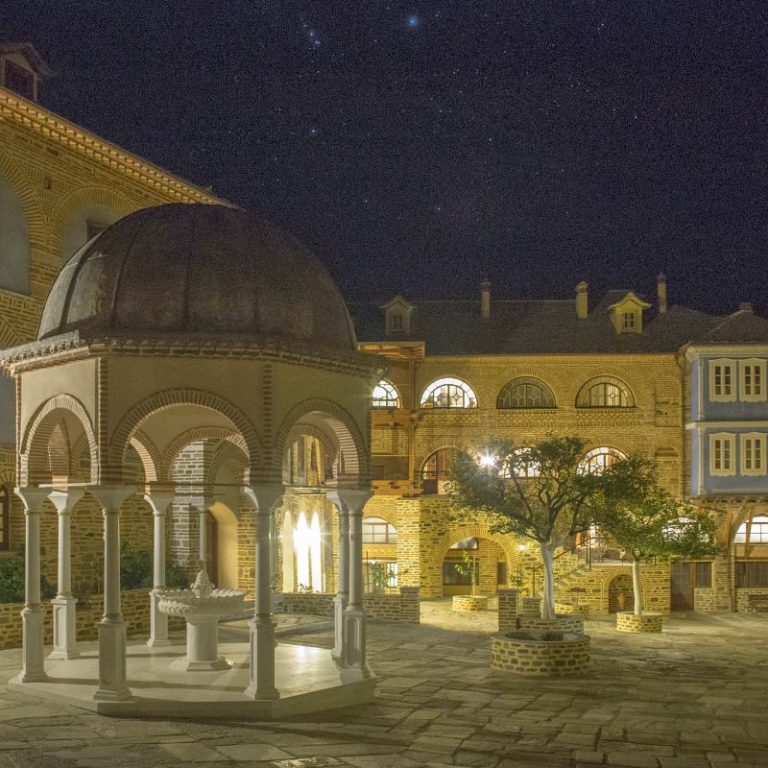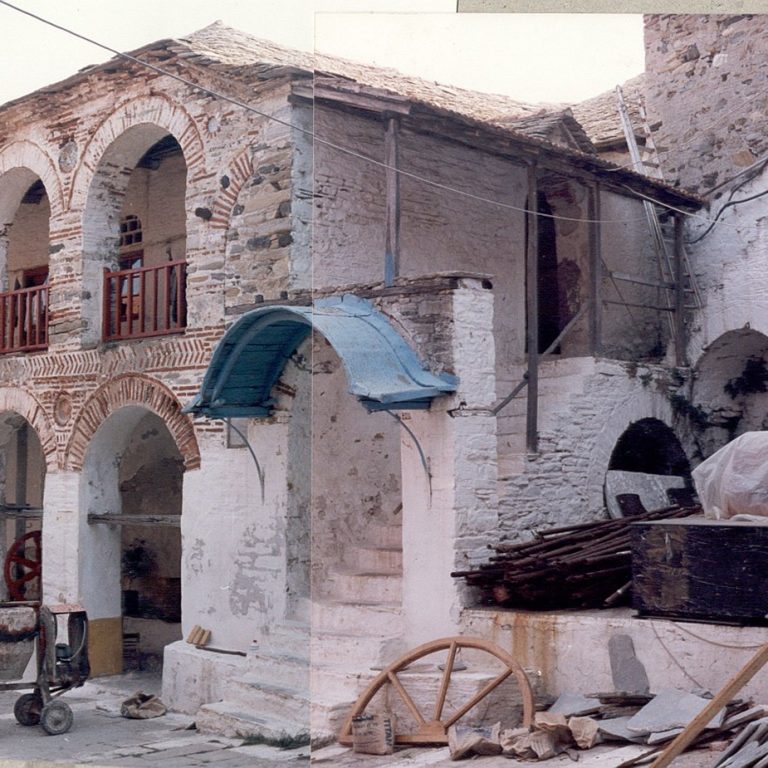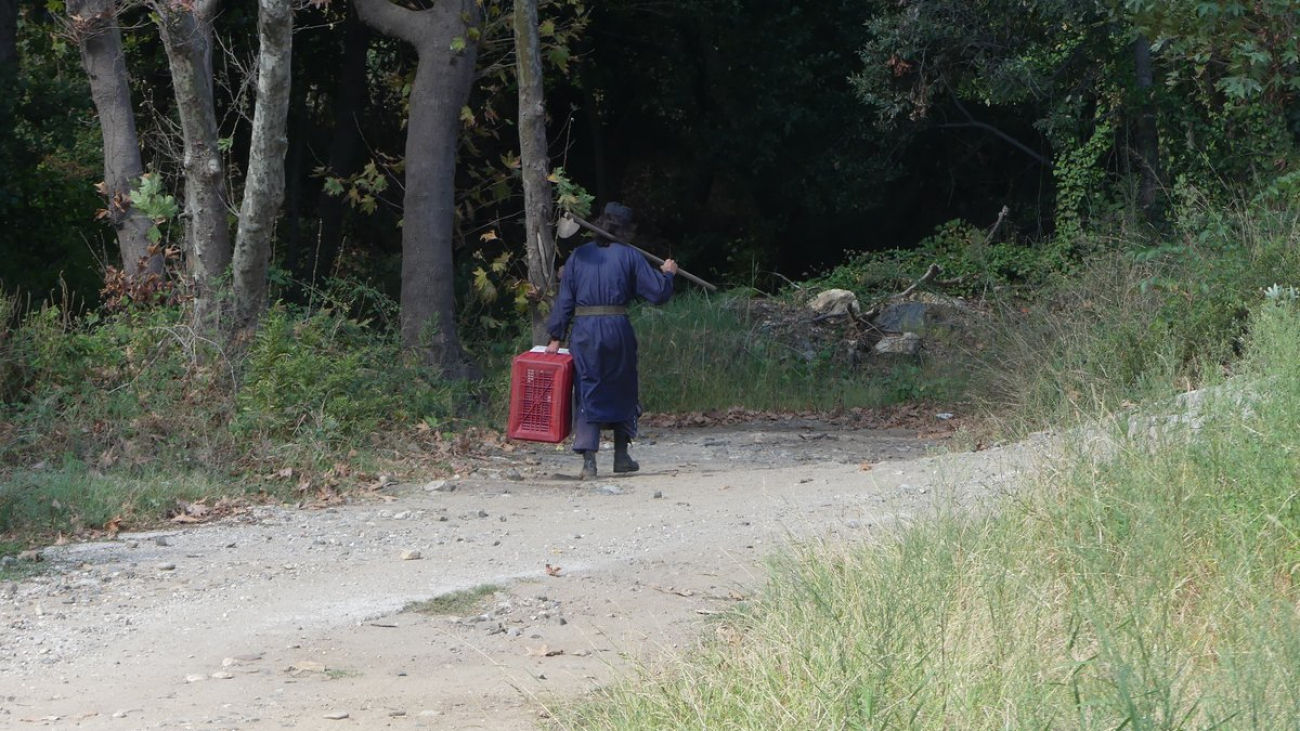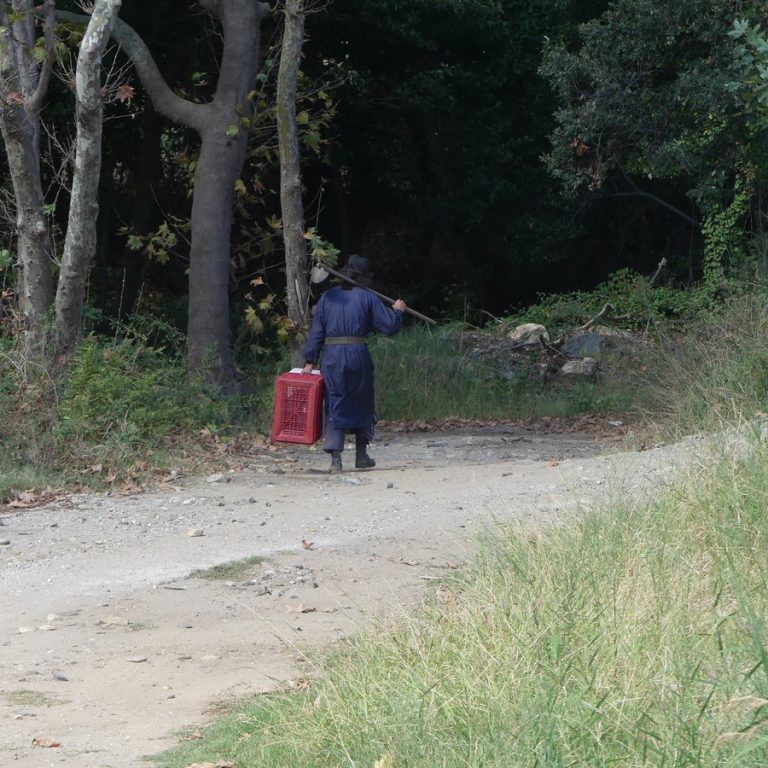Important Ascetics Who Resided At The Monastery
During the more recent historical 'biography' of the Monastery, the following Pantokratoros leaders can be singled out:
a) Benjamin of Lesbos. He was one of the most prominent representatives of the New-Hellenic Enlightenment, and played a significant role in the spiritual and historical events of the turbulent period in which he lived. He was born in Plomari in 1762, and likely joined the Monastery at a very young age, since in 1780, he was sent to the dependency of St Nikolaos in Kydonies. His acquaintance there with the scholar Ioannis Oikonomos was the starting point of a long cycle of studies, first at the School of Chios, where Athanasios Parios and Theodore Proios taught, and later in Pisa, Paris, and London, where he studied mathematics, physics, meteorology, and astronomy. Prior to 1800, he had returned to Kydonion, where he was appointed as a teacher in the Academy of the city, while after 1812, he taught in Constantiniple, in the School of Bucharest, where he also served as director, and in the Evangelical School of Smyrni. Apart from his work in education, Benjamin was also an active member of the Society of Friends, while after the independence of Greece, he participated in the Second National Convention, and was appointed Commissioner of the Aegean Islands. He died in Nafplio on 26 August 1824. It is likely that his personal tribute to the Monastery is a decorated cross from 1788, where he is referred to as Prior, a fact which confirms that for a long period of time, Benjamin had continued to be closely connected with the Monastery to which he had been inducted.
b) Archimandrite Daniel of Thasos. Daniel came from Kallirachos, Thasos, and had graduated from the Great National School prior to 1850. He served as Director of the Monastery and as a commissioner of the Holy Community in Thessaloniki before 1860. During the decade 1870-1880, he was appointed Treasurer of the dependency of Kydonieos, where he supervised the renovations which were taking place there. He died in that city on 19 February 1884, and was buried with great honour at the expense of the Holy Community.
c) Kallinikos the Hermit (1821-1884). Kallinikos was born in Synasso, Cappadocia, and studied in Athoniada before attending the Theological School of Chalkis. He was appointed as a teacher in Athoniada between the years 1864 and 1868, after which he returned to the place of his birth, where he continued his educational work, at the same time serving as a preacher. In the final period of his life, he lived outside the Monastery in the Seat of St Onofrios, where he produced a new interpretation of the Ascetics of Abbot Isaac of Syria, a work which was published in Athens in 1877. He is known for his ascetic and virtuous life; he died on 25 March 1884.
d) Daniel Stergiadis was born in Platano, Thessaly, and studied theology at the Theological School of the University of Athens during the decade 1840-1850, after which he was inducted into the Monastery, where he was appointed Director around 1860, and was awarded the title of Archimandrite in 1864. From 1850-1860, he taught at Athoniada. He died on 13 August 1885 from a serious illness.
e) Hieromonk Arsenios, was born in Asia Minor. Arsenios originally resided in the St Panteleimonos Monastery of, and was later appointed to the position of Abbot at the Zenofontos Monastery, where he served from September 1872 until 23 November 1873. He returned to the St Panteleimonos Monastery, and from there entered the Pantokratoros Monastery, where he served as spiritual advisor until his death in 1894.
f) Gregory the Deacon was born in Leibadi, Chalcidiki, and his secular name was Georgios Kopsacheilis. He was inducted into the Monastery in 1874, at the age of 20. Two years later, he was ordained as a deacon, and in 1888 as a priest, while in 1891 he was awarded the title of Archimandrite. He studied in Athoniada and served as undersecretary to the Holy Community from 1882 to 1885. He died on 12 August, 1935.
g) Agathon the Monk was born in Peristasi, Thrace, and joined the Monastery at the age of 18. In 1860, he was already the Director of the Monastery, and he was also an exceptional calligrapher. Agathon was asked by the patriarch Joachim to serve on a committee for the revision of the Typikos of the Great Church, (i.e. the book of rules governing the operating procedures of the monasteries), under the direction of G. Biolaki in 1880. In recognition of his contribution to the project, Agathon was awarded the title of Great Eccleasiarch ('Great Leader of the Church') by the Patriarch on 13 May 1882. During this same period, the Patriarch had also asked Agathon to collect subscriptions from the Agios Oros monasteries and sketes for the operation of the Theological School of Chalkis, a mission which he successfully completed. He died on 17 September, 1886.
h) Prior Joseph was originally named Ioannis Koukoutos, and he was born in Kydonies. He was inducted into the Monastery in 1894 at the age of 25, and was assigned as the Young Men's Spiritual Advisor (Pneumatiko Paisio). He became a monk in 1898, and was ordained as a deacon and priest the following year. In 1909, he was appointed as Director and Prior of the Monastery. In 1911, he was sent as Treasurer to the dependency in his place of birth, where he worked with exceptional success until his martyrdom by the Turks in 1922.
i) Prior Alexios was born in Leibadi, Chalcidiki and was originally named Apostolos Liolios. He had studied at the Gymnasio ('Middle School') of Kydonies and at the French School of Thessaloniki. He joined the Monastery in 1904 at the age of 30, and was a tonsured monk in 1906. In 1920 he became the Director of the Monastery and the following year, he was ordained as a deacon and a priest. He served the Holy Community as an undersecretary from 1914 to 1920. He died at the Monastery on 2 January 1939.
j) Theofanis of Pantokratoros lived during the first half of the 19th century. Together with his contemporaries Mathaios of Vatopedis, Iosef of Dionysious, and Nikolaos of Docheiarios, he revised the antiquated notations of Byzantine music, a work which is considered extremely significant by authorities. He also reformed parts of ecclesiastical music which had not been covered by the three well-known music interpretators Chourmouzios the Archivist, Gregory the Protopsaltis, and Chrysanthos of Madytos.
k) Hierodeacon Fotis of Kallipolis was born in Kabospyra, Kallipolis in 1875, and originally named Georgios Konstantinidis. At the age of 16, he entered the Monastery and was assigned to the care of the Elder Prior Athanasios. He was tonsured in 1893, and in 1895 was ordained as a holy deacon. Fotis was appointed Director of the Monastery in 1904, and taught at Athoniada from 1903 until 1907, having graduated from the Great National School. He served as an undersecretary in the Holy Community from 1902-1907, and as secretary until 1909. For 18 years, he served as the manager of the dependency Alexopyrgos in Limnos. He died in Athens on 2 November, 1933.
l) Archimandrite Athanasios of Madytos, whose secular name was Vasileios Chrysostomoo of Kamado, was born in 1889. He jointed the Monastery in 1901, when he was only 12 years old, and two years later, he became a monk. In June of 1910, he was ordained as a deacon, and in February 1918, as a priest in Athens, where he had moved in order to study at the Theological School. He also studied at the Great National School. On 20 January 1920, he received the title of Archimandrite and Director of the Monastery. During 1920, he served as the head secretary of the Holy Community, while from 1923-1927, he served in Athens as the proxy of the Holy Community relating to the compilation of the Charter of Agios Oros and other matters. He also held the position as head of the school of Athoniadas from 1930 to 1941. From 1945 to 1954, he taught at the Ecclesiastical School of Zanthe, where he was distinguished by his ecclesiastical nature. He died on 4 February (or 17 February, in the Julian calendar) 1959 in poverty, and was buried at the Cemetery of the Annunciation of the Blessed Mother in Thessaloniki.
a) Benjamin of Lesbos. He was one of the most prominent representatives of the New-Hellenic Enlightenment, and played a significant role in the spiritual and historical events of the turbulent period in which he lived. He was born in Plomari in 1762, and likely joined the Monastery at a very young age, since in 1780, he was sent to the dependency of St Nikolaos in Kydonies. His acquaintance there with the scholar Ioannis Oikonomos was the starting point of a long cycle of studies, first at the School of Chios, where Athanasios Parios and Theodore Proios taught, and later in Pisa, Paris, and London, where he studied mathematics, physics, meteorology, and astronomy. Prior to 1800, he had returned to Kydonion, where he was appointed as a teacher in the Academy of the city, while after 1812, he taught in Constantiniple, in the School of Bucharest, where he also served as director, and in the Evangelical School of Smyrni. Apart from his work in education, Benjamin was also an active member of the Society of Friends, while after the independence of Greece, he participated in the Second National Convention, and was appointed Commissioner of the Aegean Islands. He died in Nafplio on 26 August 1824. It is likely that his personal tribute to the Monastery is a decorated cross from 1788, where he is referred to as Prior, a fact which confirms that for a long period of time, Benjamin had continued to be closely connected with the Monastery to which he had been inducted.
b) Archimandrite Daniel of Thasos. Daniel came from Kallirachos, Thasos, and had graduated from the Great National School prior to 1850. He served as Director of the Monastery and as a commissioner of the Holy Community in Thessaloniki before 1860. During the decade 1870-1880, he was appointed Treasurer of the dependency of Kydonieos, where he supervised the renovations which were taking place there. He died in that city on 19 February 1884, and was buried with great honour at the expense of the Holy Community.
c) Kallinikos the Hermit (1821-1884). Kallinikos was born in Synasso, Cappadocia, and studied in Athoniada before attending the Theological School of Chalkis. He was appointed as a teacher in Athoniada between the years 1864 and 1868, after which he returned to the place of his birth, where he continued his educational work, at the same time serving as a preacher. In the final period of his life, he lived outside the Monastery in the Seat of St Onofrios, where he produced a new interpretation of the Ascetics of Abbot Isaac of Syria, a work which was published in Athens in 1877. He is known for his ascetic and virtuous life; he died on 25 March 1884.
d) Daniel Stergiadis was born in Platano, Thessaly, and studied theology at the Theological School of the University of Athens during the decade 1840-1850, after which he was inducted into the Monastery, where he was appointed Director around 1860, and was awarded the title of Archimandrite in 1864. From 1850-1860, he taught at Athoniada. He died on 13 August 1885 from a serious illness.
e) Hieromonk Arsenios, was born in Asia Minor. Arsenios originally resided in the St Panteleimonos Monastery of, and was later appointed to the position of Abbot at the Zenofontos Monastery, where he served from September 1872 until 23 November 1873. He returned to the St Panteleimonos Monastery, and from there entered the Pantokratoros Monastery, where he served as spiritual advisor until his death in 1894.
f) Gregory the Deacon was born in Leibadi, Chalcidiki, and his secular name was Georgios Kopsacheilis. He was inducted into the Monastery in 1874, at the age of 20. Two years later, he was ordained as a deacon, and in 1888 as a priest, while in 1891 he was awarded the title of Archimandrite. He studied in Athoniada and served as undersecretary to the Holy Community from 1882 to 1885. He died on 12 August, 1935.
g) Agathon the Monk was born in Peristasi, Thrace, and joined the Monastery at the age of 18. In 1860, he was already the Director of the Monastery, and he was also an exceptional calligrapher. Agathon was asked by the patriarch Joachim to serve on a committee for the revision of the Typikos of the Great Church, (i.e. the book of rules governing the operating procedures of the monasteries), under the direction of G. Biolaki in 1880. In recognition of his contribution to the project, Agathon was awarded the title of Great Eccleasiarch ('Great Leader of the Church') by the Patriarch on 13 May 1882. During this same period, the Patriarch had also asked Agathon to collect subscriptions from the Agios Oros monasteries and sketes for the operation of the Theological School of Chalkis, a mission which he successfully completed. He died on 17 September, 1886.
h) Prior Joseph was originally named Ioannis Koukoutos, and he was born in Kydonies. He was inducted into the Monastery in 1894 at the age of 25, and was assigned as the Young Men's Spiritual Advisor (Pneumatiko Paisio). He became a monk in 1898, and was ordained as a deacon and priest the following year. In 1909, he was appointed as Director and Prior of the Monastery. In 1911, he was sent as Treasurer to the dependency in his place of birth, where he worked with exceptional success until his martyrdom by the Turks in 1922.
i) Prior Alexios was born in Leibadi, Chalcidiki and was originally named Apostolos Liolios. He had studied at the Gymnasio ('Middle School') of Kydonies and at the French School of Thessaloniki. He joined the Monastery in 1904 at the age of 30, and was a tonsured monk in 1906. In 1920 he became the Director of the Monastery and the following year, he was ordained as a deacon and a priest. He served the Holy Community as an undersecretary from 1914 to 1920. He died at the Monastery on 2 January 1939.
j) Theofanis of Pantokratoros lived during the first half of the 19th century. Together with his contemporaries Mathaios of Vatopedis, Iosef of Dionysious, and Nikolaos of Docheiarios, he revised the antiquated notations of Byzantine music, a work which is considered extremely significant by authorities. He also reformed parts of ecclesiastical music which had not been covered by the three well-known music interpretators Chourmouzios the Archivist, Gregory the Protopsaltis, and Chrysanthos of Madytos.
k) Hierodeacon Fotis of Kallipolis was born in Kabospyra, Kallipolis in 1875, and originally named Georgios Konstantinidis. At the age of 16, he entered the Monastery and was assigned to the care of the Elder Prior Athanasios. He was tonsured in 1893, and in 1895 was ordained as a holy deacon. Fotis was appointed Director of the Monastery in 1904, and taught at Athoniada from 1903 until 1907, having graduated from the Great National School. He served as an undersecretary in the Holy Community from 1902-1907, and as secretary until 1909. For 18 years, he served as the manager of the dependency Alexopyrgos in Limnos. He died in Athens on 2 November, 1933.
l) Archimandrite Athanasios of Madytos, whose secular name was Vasileios Chrysostomoo of Kamado, was born in 1889. He jointed the Monastery in 1901, when he was only 12 years old, and two years later, he became a monk. In June of 1910, he was ordained as a deacon, and in February 1918, as a priest in Athens, where he had moved in order to study at the Theological School. He also studied at the Great National School. On 20 January 1920, he received the title of Archimandrite and Director of the Monastery. During 1920, he served as the head secretary of the Holy Community, while from 1923-1927, he served in Athens as the proxy of the Holy Community relating to the compilation of the Charter of Agios Oros and other matters. He also held the position as head of the school of Athoniadas from 1930 to 1941. From 1945 to 1954, he taught at the Ecclesiastical School of Zanthe, where he was distinguished by his ecclesiastical nature. He died on 4 February (or 17 February, in the Julian calendar) 1959 in poverty, and was buried at the Cemetery of the Annunciation of the Blessed Mother in Thessaloniki.

